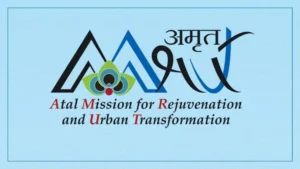
Why AMRUT Scheme in news?
- India, like many other countries, is experiencing rapid urbanization.
- This surge in urban population puts a strain on already stretched resources, leading to challenges in water supply, sanitation, pollution, and overall liveability.
- In 2015, the Indian government launched the AMRUT scheme (Atal Mission for Rejuvenation and Urban Transformation) to address these very issues.
The Dream: Accessible Water, Public Spaces, and Reduced Pollution
- AMRUT aimed to provide basic amenities to improve the quality of life in urban areas, particularly for the underprivileged.
- The mission had three key objectives:
- Universal access to safe water and sanitation: This included ensuring every household had a tap connection with a guaranteed water supply and a sewerage connection.
- Improved urban aesthetics: The scheme focused on developing green spaces and well-maintained parks, thereby enhancing the visual appeal and recreational opportunities in cities.
- Reduced pollution: AMRUT promoted a shift towards public transport and facilities for non-motorised transport like cycling and walking, aiming to curb air and noise pollution in urban areas.
- The initial phase of AMRUT, launched in 2015, had a total outlay of ₹50,000 crore for five years. Recognizing the ongoing need, AMRUT 2.0 was launched in 2021 with a significantly larger budget of ₹2,99,000 crore for another five years.
Progress on the Ground: A Mixed Bag
- So far, AMRUT has shown progress in some areas. As of May 19, 2024, a significant amount has been disbursed for projects like providing tap connections (over 58 million), building parks (over 2,400), and replacing streetlights with energy-efficient LEDs (over 62 million).
- However, the reality on the ground paints a somewhat concerning picture.
- India continues to grapple with water scarcity and sanitation issues.
- Millions of urban households lack access to piped water and proper sewage systems. Additionally, air quality in many AMRUT cities remains a major concern.
The Cracks in the Facade: Why AMRUT Needs a Course Correction
- Despite its good intentions, AMRUT has faced criticism for its shortcomings. Here are some key areas where the scheme can be improved.
- Lack of Holistic Approach: AMRUT adopted a project-by-project approach rather than a comprehensive urban development strategy. This fragmented approach often fails to address the interconnectedness of urban challenges.
- Limited Local Participation: The scheme was designed with minimal involvement from the very cities it aimed to improve. This top-down approach overlooks the unique needs and contexts of each urban center.
- Inadequate Water Management: The scheme did not adequately consider factors like local climate, rainfall patterns, and existing infrastructure when planning water management projects. This has led to inefficient water and sewage treatment systems.
- Dominance of Private Interests: Critics argue that AMRUT has been driven more by private companies and real estate developers than by a genuine concern for sustainable urban planning. This has resulted in the prioritization of development projects over environmental considerations.
The Way Forward: A People-Centric Approach
- AMRUT Scheme potential remains largely untapped. Here’s how the scheme can be made more effective:
- Embrace a Holistic Vision: AMRUT scheme needs to move towards a city-wide planning approach that considers all aspects of urban development, including water, sanitation, transportation, and public spaces.
- Empower Local Bodies: Active participation of elected city governments and local communities is crucial. AMRUT should be redesigned to give them ownership and decision-making power.
- Nature-Based Solutions: Sustainable and nature-based solutions for water management, such as rainwater harvesting and wetland restoration, should be prioritized.
- Focus on Sustainability: AMRUT scheme should integrate environmental considerations into all projects to ensure long-term sustainability and reduce pollution.
Conclusion
- AMRUT Scheme has made some strides in improving urban infrastructure, but significant challenges remain.
- By adopting a more holistic, participatory, and nature-centric approach, AMRUT can truly transform Indian cities into livable and sustainable spaces for all.
People also ask
Q1: What is the AMRUT scheme?
Ans: The Atal Mission for Rejuvenation and Urban Transformation (AMRUT) scheme is a flagship program launched by the Indian government to improve basic amenities and infrastructure in cities. Its main focus areas are water supply, sanitation, public spaces, and urban mobility.
Q2: What were the goals of AMRUT scheme?
Ans: The AMRUT scheme aims to create a complete urban transformation by ensuring every household has access to clean water and sanitation, enhancing cityscapes with parks and green spaces for a more pleasant living experience, and promoting public transport and non-motorised options like cycling and walking to reduce pollution.
Can you be more specific about the content of your article? After reading it, I still have some doubts. Hope you can help me.
Can you be more specific about the content of your article? After reading it, I still have some doubts. Hope you can help me.